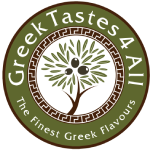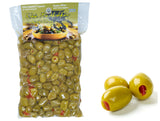Have Questions?Ask An Expert
Greek Frumenty / Trahanas Traditional Pasta with Dehydrated Vegetables, Net 880g.
Trustify review stars will be displayed here!
-
Greek Frumenty / Trahanas Traditional Pasta with Dehydrated Vegetables, Net weight 880g ( Pack of 4 boxes of 200g each ):
Frumenty is one of the most characteristics of Greek products. It is made from wheat flour and its shape looks like an irregular-shaped thick grain. The traditional way of making frumenty was by rubbing the dough between the hands and over sieves with a thick grid, and then by spreading it over crates with a steel grid until it dried well. It is characterized by its high nutritional value, its few calories and low-fat content. Pasta contains considerable amounts of minerals such as magnesium, iron, calcium, potassium, zinc, selenium and manganese. Also contains a small amount of sodium, and has no cholesterol, contains vitamin B, which includes folic acid and niacin.
In the past, Greek villagers made pasta mostly in the summertime when they could dry it naturally. They would then keep it in the cellar of their homes and cook it in winter. It was thus a very convenient and easy food to prepare and a wonderful solution to feed a large and hungry family both economically and in a most nourishing way. The shape, size and cooking method of the Greek traditional pasta varies, depending on the region.
Trahana is an ancient food that fewer and fewer country cooks bother to make at home. But Greeks still love it and as a result, a litany of regional artisan producers have stepped in to fill market demand. Thanks to them the tradition is surviving. In Crete, cooks add the local trahana, called xinohondros, to a whole range of vegetable dishes. Trahana goes hand in hand with tomatoes in a delicious northern Greek meatball soup and cooks sometimes add it instead of breadcrumbs to the meatballs themselves, to help keep the mixture together.
Pasta meals are central to the Greek Mediterranean Diet and are eaten with their plate partners, such as vegetables, fish, olive oil, cheese, tomato sauce, poultry and meat.
Key Product Features:
i) Raw Ingredients, No Preservatives, Great Taste & High Nutritional Value.
ii) Made by using traditional old techniques, with finest raw ingredients and vegetables from the village and the Greek Macedonian valleys.
iii) Quick and easy to prepare, with amazing taste and unlimited choices like vegetables, meat, fish or poultry to combine with.
iv) Pasta meals are central to the Greek Mediterranean Diet, with high nutritional value. Suitable for vegetarians.Storage Instructions: Store in a clean, dry and cool place. In a pan over medium heat add olive oil & Frumenty/Trahanas. Stir until the pasta is lightly toasted for 3 minutes, then add 400ml of broth. Cook, stirring periodically to prevent pasta from sticking to the pan until the broth has been absorbed, about 3 minutes. Repeat with another 400ml broth until the liquid has been absorbed, 5 minutes more. Test the doneness of the pasta. Remove the Frumenty/Trahanas pan from the heat and vigorously stir in the Parmesan cheese and butter. Season to taste.
-
Ingredients :
-
-
Greek Frumenty / Trahanas Pasta from Wheat Flour,
-
Carrot / Celery / Onion / Spinach / Chives, Montana / Garlic / Potato (Dried) ,
-
Salt.
-
-
-
Cultivation under the Integrated Management Crop system ISO 22000:2005 and AGRO 2-1, AGRO 2-2 certified. Cultivation area: Serres, from rich plains of Macedonia in northern Greece.
-
Greek Frumenty / Trahanas Traditional Pasta with Dehydrated Vegetables, Net weight 880g ( Pack of 4 boxes of 200g each ):
Frumenty is one of the most characteristics of Greek products. It is made from wheat flour and its shape looks like an irregular-shaped thick grain. The traditional way of making frumenty was by rubbing the dough between the hands and over sieves with a thick grid, and then by spreading it over crates with a steel grid until it dried well. It is characterized by its high nutritional value, its few calories and low-fat content. Pasta contains considerable amounts of minerals such as magnesium, iron, calcium, potassium, zinc, selenium and manganese. Also contains a small amount of sodium, and has no cholesterol, contains vitamin B, which includes folic acid and niacin.
In the past, Greek villagers made pasta mostly in the summertime when they could dry it naturally. They would then keep it in the cellar of their homes and cook it in winter. It was thus a very convenient and easy food to prepare and a wonderful solution to feed a large and hungry family both economically and in a most nourishing way. The shape, size and cooking method of the Greek traditional pasta varies, depending on the region.
Trahana is an ancient food that fewer and fewer country cooks bother to make at home. But Greeks still love it and as a result, a litany of regional artisan producers have stepped in to fill market demand. Thanks to them the tradition is surviving. In Crete, cooks add the local trahana, called xinohondros, to a whole range of vegetable dishes. Trahana goes hand in hand with tomatoes in a delicious northern Greek meatball soup and cooks sometimes add it instead of breadcrumbs to the meatballs themselves, to help keep the mixture together.
Pasta meals are central to the Greek Mediterranean Diet and are eaten with their plate partners, such as vegetables, fish, olive oil, cheese, tomato sauce, poultry and meat.
Key Product Features:
i) Raw Ingredients, No Preservatives, Great Taste & High Nutritional Value.
ii) Made by using traditional old techniques, with finest raw ingredients and vegetables from the village and the Greek Macedonian valleys.
iii) Quick and easy to prepare, with amazing taste and unlimited choices like vegetables, meat, fish or poultry to combine with.
iv) Pasta meals are central to the Greek Mediterranean Diet, with high nutritional value. Suitable for vegetarians.Storage Instructions: Store in a clean, dry and cool place. In a pan over medium heat add olive oil & Frumenty/Trahanas. Stir until the pasta is lightly toasted for 3 minutes, then add 400ml of broth. Cook, stirring periodically to prevent pasta from sticking to the pan until the broth has been absorbed, about 3 minutes. Repeat with another 400ml broth until the liquid has been absorbed, 5 minutes more. Test the doneness of the pasta. Remove the Frumenty/Trahanas pan from the heat and vigorously stir in the Parmesan cheese and butter. Season to taste.
-
Ingredients :
-
-
Greek Frumenty / Trahanas Pasta from Wheat Flour,
-
Carrot / Celery / Onion / Spinach / Chives, Montana / Garlic / Potato (Dried) ,
-
Salt.
-
-
-
Cultivation under the Integrated Management Crop system ISO 22000:2005 and AGRO 2-1, AGRO 2-2 certified. Cultivation area: Serres, from rich plains of Macedonia in northern Greece.




























